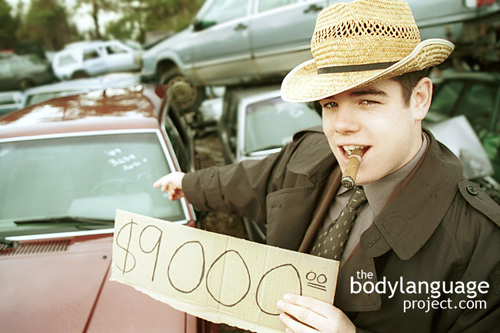Research by Harvard Robert Rosenthal conducted in the 1960s showed how people see what they want to see, instead of what’s really happening. In his study, he had set up two groups of students with a maze constructed for their subjects – rats. One group of students were told that their rats where “dumb” and the other group was told that their rates were “smart”, specifically bred to run mazes better then the other rats. While both sets of rats performed equally as well, the students with the preconceived notion that their rats where dumb catalogued behaviours supporting their initial impressions. The students with the “dumb” rats found that they were lethargic and dull. The rats of the group who thought they had smart rats documented how bright, alert and efficient the rats where as they made their way through the maze. Clearly from this study, our preconceived notions are potent and misleading. The same pitfalls can arise during the analysis of body language. If we truly wish to see nervous, emotional or confident body language, we will. But if we open our minds, we might see something completely different from what we initially expected to see.

Can this shyster ever be trusted?
Intuition includes the processing of information that we’ve obtained by observing people. When someone says they have a “bad” feeling about someone or they feel “uneasy” or the salesman was “slimy” they are using their intuition. Sometimes though, our intuition becomes clouded by preconceived notions and new information is tainted or distorted. This is when reading people can backfire to hurt us and others. When reading people it is important to clean the slate continuously and read each cue separately. While the rule of fours says we need to add cues together to discover the true meaning, using proper intuition without distortion, means we need to read each cue on their own. It means we need to avoid looking for hints we can use to support our conclusion, they are either there or aren’t there. In fact, the conclusion needs not play into the equation at all when reading but rather be a formulated after we have analyzed all the available information.
Many optical illusions or visual tricks rely on the fact that our brains are constructed to find information we think should be there, rather than looking at information that is actually there.
It’s easy to silence our intuition and ignore it since that little voice inside our heads is always trying to speak out and it’s only right some of the time. Let’s take poker again as an example. We found that baselining an individual can help in many ways most notably to help us reference behaviour, however, it would be disastrous to continue to call or raise someone who normally bluffs just because we have a strong hand, say a full house. In this situation, we are ignoring the current behaviour of the individual in favour of preconceived notions about them. As the hand plays out, we find that this bluffer continues to call even on our strongest bets, we find that sometimes they even raise or re-raise pushing the stakes even higher. Naturally, they’ve caught a rare hand, four of a kind, and easily crushing our full house. We’ve missed all the signals. The clues given all along were consistent with a strong position but we failed to read it correctly because we ignored all the rules. The information coming told use to read his moves at face value instead of modifying it to suite our needs, but at every step we ignored this. Our filters are important in simplifying information since it’s impossible to analyze everything going on around us, but we shouldn’t throw aside good information.
Having a good intuition is often not enough though. A “funny feeling” or “having a sense” or being “uneasy” about someone or something has merit, but if you can’t support your intuition with support such as postures and signals or in the case of poker “tells”, then we can’t graduate into a full reader of body language.
When we describe our intuition to others, we also need the proper vocabulary to convey our feelings to them. But this isn’t the only time we need to use the proper language of nonverbal reading, in fact, we need to train the little voice inside our head to also talk us through as we read others. When I watch someone, I can say unequivocally, that I think they are a timid, or confident or lack confidence and use specific examples. By the end of this book and with a little bit of practice, you will be able to do the same. As you learn, don’t be afraid to review the information in your head. Every mind is built differently, and I have a gift (when I’m actively listening) to remember verbal dialogue that has transpired years previous whilst recalling specific sentences used, the context and the location. Unfortunately for others, and sometimes fortunately for me, this has made me a very powerful debater. I can remain one hundred percent consistent in my position and use inconsistencies across the short or long term, to point out errors in reasoning of others. I can also cite specific instances that lead me to modified my position on things which can later help should I change my defense. Your mind might have more visual strengths, or analytical skills, or something else to help you dissect the cues of others. The point here is to use your strength in reading people rather then to focus on your weaknesses. Regardless however, do be aware of your flaws as it will make you a stronger reader overall.

She really liked me, she was really showing skin…or is she just sweating to death? It’s the sender that determines the intent of the message, not the body language reader.
Here are some final tips for reading via intuition. When in doubt, trust your gut as usually, but not always, it’s right and can be your saviour when we can’t pinpoint specific cues. Switch your mind back on and be more than just a casual observer of your environment. In the Sherlock Holmes book, A Scandal in Bohemia, Holmes tells Watson that he knows there are seventeen steps leading up to Baker Street. Watson was impressed by his observations, but it didn’t happen through magic, it was not more than simple observation. While Watson had merely seen the steps, Holmes had actively observed them. In a study by Simons and Chabris in 1999 out of Harvard University, Cambridge it was shown just how poor people are as observers of their surroundings. In the study a man walked in front of a group of students dressed in a gorilla suit while other activities took place around them. Half of the students hadn’t even noticed the “gorilla in their midst” which aptly formed part of the title to the study! It just goes to show that passive watching and active observing are two very different things, and this is what will separate average body language readers that cover the material like anyone else, even recall it, but two weeks later, become half as effective or worse, from those who build on their skills daily on their way to mastery. Active observation is a key ingredient to reading people and it can’t be done walking around blindfolded, however, even with a keen eye there will still be signals that go unnoticed as body language is fluid, ever changing and sometimes never repeating, meaning you only get one shot to catch a signal before it’s gone forever. Life is rich in detail and complex, we’d be fools to think we could read everything, but even with minimal effort, we can still impress others, and even ourselves, with how much can be read.
Remember too that it is always your job to determine the true intent of the sender, whatever cues they give off. Once you’ve caught cues that you think matter, remember that it is the sender of the message that determines it’s meaning, not the receiver.
This all sounds like a lot of work, but don’t worry, with practice your mind essential shifts back into autopilot and the process happens naturally. With time and practice, your subconscious will pick up and interpret skills all by itself without requiring active thought.



